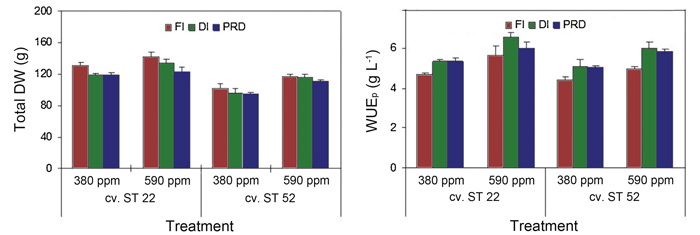| Follow @co2science |
Paper Reviewed
Pazzagli, P.T., Weiner, J. and Liu, F. 2016. Effects of CO2 elevation and irrigation regimes on leaf gas exchange, plant water relations, and water use efficiency of two tomato cultivars. Agricultural Water Management 169: 26-33.
Model projections suggest that mid-latitude regions could experience a higher frequency of seasonal drought as a result of CO2-induced global warming. Therefore, in the words of Pazzagli et al. (2016), "an understanding of plant responses to rising CO2 concentration and limited water availability is necessary for maximizing crop yield and quality under future climate scenarios." And to help move our understanding forward in this regard, the team of three researchers from Denmark set out to investigate "the independent and combined effects of CO2 enrichment and reduced irrigation on two tomato cultivars with potentially different responses to drought and heat stress."
To accomplish their objective, Pazzagli et al. grew two tomato (Solanum lycopersicum) cultivars -- one potentially drought tolerant (ST 22) and one thought to be heat tolerant (ST 52) -- in a controlled greenhouse environment from March to June 2014 at the experimental farm of the University of Copenhagen located in Taastrup, Denmark. Therein, the plants were subjected to three different irrigation regimes (full irrigation, deficit irrigation and partial root-zone drying) and two atmospheric CO2 concentrations (380 and 590 ppm). And what did their study reveal?
Statistical analyses indicated there was a significant CO2 effect on both cultivars for net photosynthetic rate, intrinsic water use efficiency (WUEi, photosynthetic rate/stomatal conductance), plant water use efficiency (WUEp, aboveground biomass/plant water use), root water potential, stem dry weight, leaf dry weight, total dry weight (see figure below) and flower number. More specifically, the photosynthetic rate was 30% higher in plants grown at 590 ppm compared to those grown 380 ppm, total plant dry weight averaged 13.5% higher (18% for ST 52 and 9% for ST 22) and WUEp increased by 25% in ST22 and 13% in ST 52.
Figure 1. Dry weight and plant water use efficiency of two tomato cultivars subjected to two CO2 (380 or 590 ppm) and three watering treatments (Full Irrigation, FI, Deficit Irrigation, DI, or Partial Root-zone Drying, PRD). Adapted from Pazzagli et al. (2016).
In summing up their findings, Pazzagli et al. write that "despite large differences between the cultivars, both of them showed significant improvements in plant water use efficiency under both reduced irrigation and CO2 enrichment, as well as under the combination of the two treatments." In the future, therefore, these two tomato cultivars should benefit from Earth's rising atmospheric CO2 concentration.
Posted 7 September 2016



